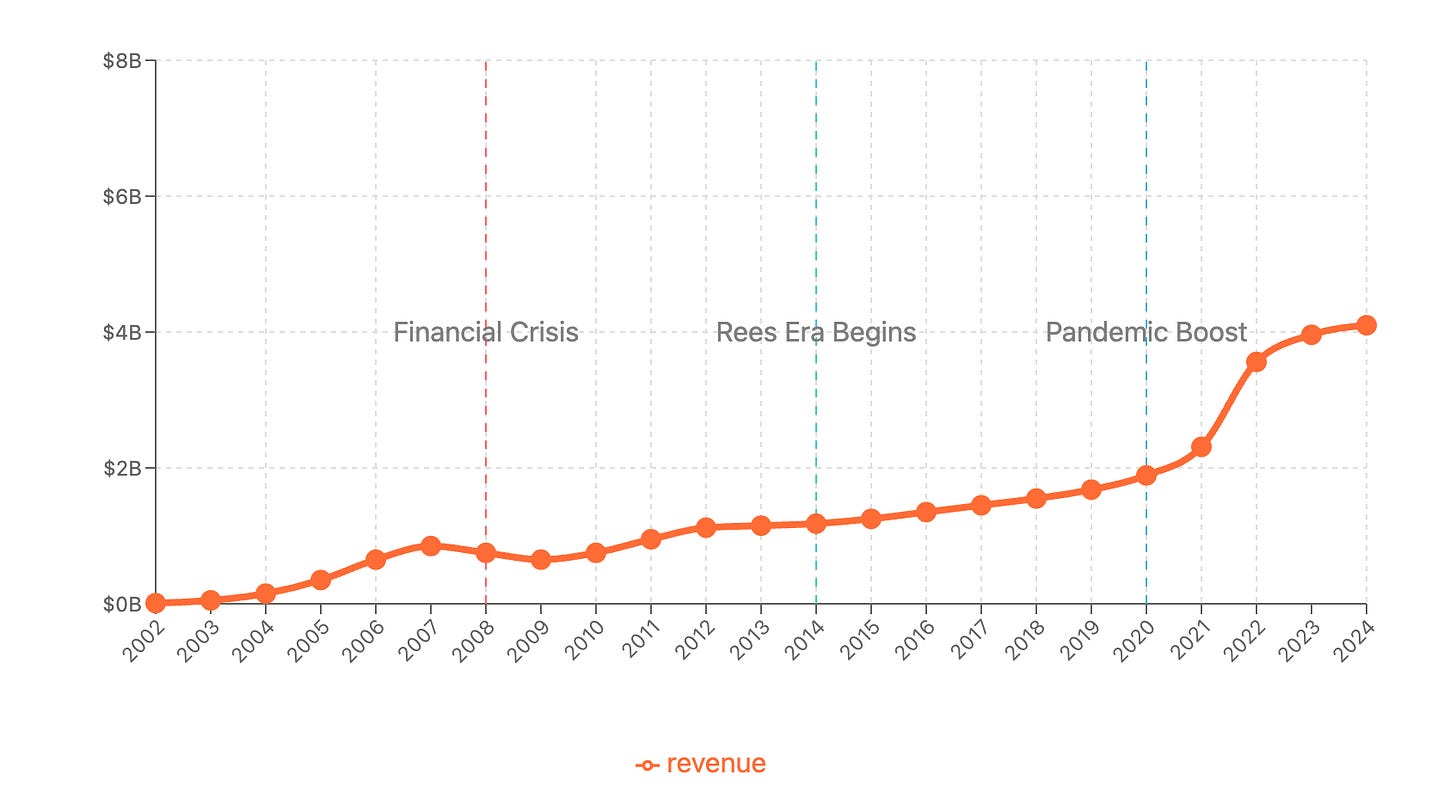How Crocs Became a Success: The Ultimate Comeback Story
Under the Hood: How did Crocs turn things around.
A Deep Dive Into Crocs’ Strategic Comeback and How Bold Focus, Culture Collabs, and Operational Clarity Turned a Fading Fad Into a Global Force
I recently went to the mall and saw a line outside the Crocs store, people waiting to get their hands on the latest designs. This got me thinking. I used to hate them when they first launched, but now I own over 3 pairs and have been looking to get their new style. When did my mindset about Crocs shift without me knowing? This consumer mindshift that Crocs created is what intrigued me to dive deep into their story.
What I discovered was one of the most remarkable turnaround stories in modern business history—a tale of three friends, a near-death experience, and a strategic mastermind who turned the company's greatest weakness into its most powerful asset.
The Accidental Beginning
The Crocs story begins not in a boardroom or design studio, but on a sailing trip in the Caribbean in 2002. Three friends from Colorado—Scott Seamans, Lyndon "Duke" Hanson, and George Boedecker Jr.—stumbled upon something that would change their lives forever. They discovered a Canadian company called Foam Creations that had developed a lightweight foam clog design perfect for boat decks.
These three entrepreneurs had no shoe industry experience whatsoever, but they saw potential in this quirky design. They named their company "Crocs" because, like crocodiles, their shoes were designed to handle both land and water. The concept was simple: create a comfortable, practical shoe that could transition seamlessly between different environments.
The Explosive Launch
In November 2002, the Crocs clog made its debut at the Fort Lauderdale International Boat Show with its first model, "The Beach." The response was immediate and overwhelming—attendees snapped up all 1,000 pairs the company had to offer. This wasn't just a successful product launch; it was a phenomenon waiting to happen.
What followed was nothing short of extraordinary. From 2002 to 2007, Crocs experienced meteoric growth that defied all business logic. The company went public and became one of the fastest-growing footwear brands in history. By 2007, they had reached peak revenue of approximately $850 million, growing from virtually nothing to nearly $1 billion in just five years.
The distinctive foam clogs became a cultural phenomenon. Love them or hate them, you couldn't ignore them. They were everywhere—on celebrities, healthcare workers, gardeners, and beach-goers. The rapid production enabled by their simple foam mold design allowed Crocs to fulfill orders quickly and capitalize on the growing demand.
The Great Collapse
Then came 2008, and everything changed. The financial crisis hit Crocs particularly hard, creating what the company would later call a "life or death situation." The Boulder, Colorado, company watched helplessly as its popularity sank and inventory piled up on store shelves. Sales started to plummet, forcing the company to cut thousands of jobs.
The numbers tell a devastating story: revenue dropped by approximately $200 million over the next two years, falling from the $850 million peak to around $650 million. The company's stock price crashed to as low as $0.79—a 99% decline from its highs. Auditor Deloitte & Touche issued a going-concern qualification, citing operational losses and the imminent threat of bankruptcy.
Many predicted that Crocs would become nothing more than a footnote in fashion history—a cautionary tale about fads and the dangers of rapid growth. The brand that had once been everywhere was suddenly toxic, with retailers refusing to carry their products and consumers moving on to other trends.
The Turnaround Begins
In March 2009, John Duerden, a turnaround expert who had previously run Reebok, arrived at the helm to begin the painful process of restructuring. He closed factories, cut nearly a third of the company's workforce, and worked to eliminate the excess inventory that was choking the business.
The recovery was slow and methodical. By 2010, the stock had rebounded to $15.50, and revenues started growing again, reaching $1.12 billion in 2012. However, growth then plateaued around $1.1-1.2 billion, and many analysts believed it could take years for Crocs to become truly profitable again.
What the company needed wasn't just operational fixes—it needed a complete strategic transformation. And that's exactly what they would get.
Enter Andrew Rees: The Architect of the Renaissance
The most pivotal moment in Crocs' history came when Andrew Rees first encountered the company. Initially hired as a consultant by L.E.K. Consulting to develop turnaround strategies for the struggling shoe company, Rees impressed leadership so much that he was brought in as President in 2014 and promoted to CEO in 2017.
This wasn't just a typical executive hire; Rees was a strategic visionary who understood something fundamental about the Crocs brand that others had missed.
The Transformation Strategy
Under Rees' leadership, Crocs embarked on a comprehensive transformation that would redefine the entire company. His strategy was built on several key pillars:
Operational Excellence: Rees ditched about 170 underperforming stores, cleaned up distribution channels, and refocused the entire company on the iconic Classic clog. Instead of diversifying into multiple shoe categories, they doubled down on what made them unique.
Brand Repositioning: Rather than fighting against the "so ugly they're good" reputation, Rees made a counterintuitive decision to embrace it completely. He turned their polarizing design into a well-planned business strategy, making their unconventional appearance a badge of honor rather than a liability.
Strategic Partnerships: Rees inked buzz-building collaborations with high-end brands like Balenciaga and Takashi Murakami, celebrities like Justin Bieber and Post Malone, and creative partnerships with companies ranging from Pixar to PizzaSlime. These collaborations elevated Crocs from a simple comfort shoe to a legitimate fashion statement.
Digital Marketing Revolution: The company invested heavily in digital marketing and social media, particularly targeting younger audiences on platforms like TikTok and Instagram. The hashtag #crocs gained 1.6 billion views on TikTok alone, with the brand encouraging customers to share their unique experiences using dedicated hashtags.
Perfect Timing: The Pandemic Boost
Just as Rees' strategy was gaining momentum, the COVID-19 pandemic created an unprecedented opportunity. The global shift to remote work and the emphasis on comfort created massive demand for comfortable footwear. Crocs' timing was perfect—they had already positioned themselves as the ultimate comfort shoe.
Healthcare workers on the front lines embraced Crocs for their comfort during long shifts. People stuck at home wanted shoes that prioritized comfort over formality. The assistance Crocs offered to combat the pandemic and their direct communication with consumers helped them gain even more success during this critical period.
The Numbers Don't Lie
The Anomalous Insight:
Crocs had achieved something extraordinary in business, and there are powerful lessons that any visionary can apply:
Transform Your Biggest Weakness Into Your Greatest Strength. Instead of fighting the "ugly shoe" reputation, Rees embraced it completely and made it a strategic advantage. Sometimes what makes you different is exactly what will make you successful.
Focus Ruthlessly on What Works. Rees closed 170 underperforming stores and refocused entirely on the Classic clog. When you find your core strength, double down on it rather than diversifying into mediocrity.
Timing Matters, But Preparation Makes the Difference. The pandemic created perfect conditions for Crocs, but they were only able to capitalize because Rees had already repositioned the brand for comfort and authenticity.
Strategic Partnerships Can Elevate Perception. Collaborations with high-end brands like Balenciaga and celebrities like Post Malone transformed Crocs from utility wear to a fashion statement, proving that the right partnerships can redefine entire categories.
Community Building Beats Traditional Marketing. By encouraging user-generated content and creating authentic experiences, Crocs built a movement rather than just selling products. Their 1.6 billion TikTok views came from customers, not ads.
The company's vision for the future is equally ambitious. Andrew Rees has stated that they expect the Crocs brand to grow to over $5 billion in sales by 2026, maintaining industry-leading profitability while creating significant shareholder value.
The Crocs story offers a powerful lesson for anyone building something unconventional.
Sometimes the most successful path isn't about fitting in—it's about embracing what makes you different and turning that difference into your competitive advantage.
The next time you see someone wearing Crocs, remember: you're looking at the result of one of the most remarkable turnarounds in modern business history—a company that went from near-bankruptcy to becoming a global phenomenon by embracing exactly what made them weird.
Metrics That Matter
1. Core SKU Contribution:
The percentage of revenue driven by one product line (in Crocs’ case, the Classic clog).
Core SKU Contribution = (Revenue from Core Product ÷ Total Revenue) × 100
Why it matters: Crocs leaned into their hero product instead of diluting focus. If your “core” isn’t pulling most of the weight, you may be spread too thin.
2. Collaboration Impact Index:
Measure the sales lift and brand visibility tied directly to collabs.
(Collaboration Revenue ÷ Total Revenue) × 100 + (Collab-Driven Social Impressions ÷ Total Impressions) × 100
Why it matters: Partnerships with Balenciaga, Bieber, and Post Malone weren’t just PR stunts—they translated into real cultural capital and sales. Track whether your collabs actually move the needle.
3. Digital Engagement Velocity
How quickly brand campaigns generate engagement across platforms.
Engagement Velocity = (Total Engagements ÷ Time Period in Days)
Example: Crocs’ TikTok hashtag hit 1.6B views—proof that community-generated content can move faster than paid ads.
Why it matters: In digital-first marketing, speed matters as much as scale. If you can’t generate velocity, you can’t stay in culture.
4. Store Productivity Ratio
Revenue per store vs. operating costs.
Store Productivity = (Revenue ÷ # of Stores)
Why it matters: Rees closed 170 underperforming stores to increase productivity per door. Sometimes growth comes from subtraction, not addition.
5. Comfort Adoption Rate
Share of consumers buying for comfort-first use cases (work-from-home, healthcare, leisure).
Comfort Adoption = (Comfort-Driven Sales ÷ Total Sales) × 100
Why it matters: Crocs capitalized on the pandemic surge because they had already positioned themselves as the ultimate comfort shoe. If you’re not measuring what drives purchases, you’re guessing.
6. Price Elasticity of Weirdness
How much consumers will pay once a “polarizing” product becomes a cultural statement.
(Avg. Selling Price Pre-Repositioning ÷ Avg. Selling Price Post-Repositioning) × 100
Why it matters: Turning “ugly” into aspirational gave Crocs pricing power. What consumers once dismissed became collectible—and more profitable.
Under the Hood is where we dissect culture, strategy, and business moves that matter. Whether you’re bootstrapping a dream or scaling your empire or working on your side hustle, these are the receipts that help you move smarter.
Till next week—
Be bold. Be real. Be anomalous.





